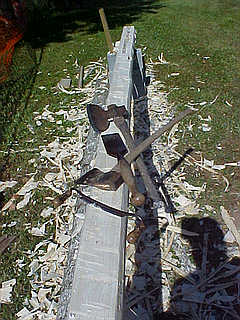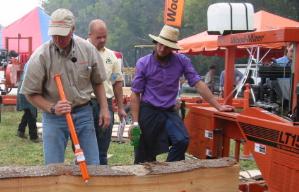Question
In June, I will be going to Africa for a couple of weeks to work with pastors and child soldiers. Our goal is to reintegrate these kids back into their society. We want to help them learn a trade. Congo is a tropical climate, and as you might guess, has plenty of African mahogany. It was amazing to see how much ribbon striped mahogany was everywhere. They use it like we use pine.
Anyway, I have one week to teach these guys how to use primitive tools like handsaws, chisels, and brace and bit to make timber frame/post and beam buildings. I have owned and operated a millwork shop for many years. I have some, but little, experience making trees into lumber.
If you had 40 hours, how would you teach young adults and older teens to go from tree to lumber? Again, we will be using hand tools, as gas is very expensive... even more than here!
Forum Responses
(Sawing and Drying Forum)
From Professor Gene Wengert, forum technical advisor:
Sawing a log without electricity or gasoline power is next to impossible. The only option I know of is called a pit saw. Google it. It is not very effective and is not kind to the operator under the saw.
Also, it might be a good thing to round up as many hand tools here in the US as you can afford to ship over there (don't forget sharpening stones and files). Going to the hardware store and getting anything we need is something we take for granted, but may not be possible in Africa.
Again, thanks. I will check Foxfire and Fox Maple. And members of our group are active in Costa Rica, too. They saw people replanting with pine trees. They said that they grow quickly in the tropical climate.
Gene is right, the only way without gas will be the pitsaw. Did you mean, "No trucks, but horses," or "No trucks or horses." If the latter is the situation, I reckon you are facing Mission Impossible. On the other hand, if horses or oxen are available, I have a few ideas.
Sorry about the confusion - no horses that I know of.
I sure would like to find a way so that they could slab where it falls. I wonder if you could rig up a jig like they use for chainsaws that follow a 2x guide? I am thinking of capturing the blade like the old miter boxes used to hold a backsaw. If there is a way to hold the saw on both sides of the log, then they could saw horizontally and not need a pit. What about drying the timbers? How did they know when it was dry enough to use 200 years ago?
I have not read this but I believe the pit saw was used only on logs that had already been hand hewn into a beam. This is because the pit saw is based off of a saw captured within a frame, and the frame rides on the two outside faces of the beam that the blade is within.
All the tools back from these days are very primitive, so there are many versions and varieties, simply whatever worked and got the job done. The basic tools you need are crosscut two man saws, axes, double bit would be nice, broad axes - with the correct bent offset handle, and a variety of adzes. You can find all these tools affordable at the right places, but the original tools pop up on eBay all the time, and very affordable prices. Two man log carrying tongs would be very handy also.
Just my opinion, but if you compare our country with theirs, they are something like where we were 300 years ago, just settling into the wilderness of this country, with the bare essentials. You're looking at a once in a lifetime opportunity to put an axe to ribbon mahogany, and justify it!
There is a short description of a pit saw at Wikipedia. It states that the pit sawyers were some of the highest paid people in Colonial America. Note that seldom was a pit saw in a frame... That was a later patented idea, but it really never was popular, as it was too heavy and too hard to steer and handle.
I remember being impressed with the accuracy of the lumber. It was some kind of pine. We were right next to a huge government plantation. I watched a logging crew one afternoon. The only mechanization they had was a chainsaw. They let me cut a tree down. I tried to swing it a bit, but there was no strength in the wood compared to the wood we have in BC. They were impressed that I could do it. I made a big print of one of the pictures I took and sent it to them. I'd have loved to send them some of the big wood I've felled.
I met a guy one time that was overseas with a WM mill and they broke a blade. Some young guys were there and asked for the blade. They made a bow saw out of it and were cutting logs into boards with it.
Whatever tools you take, remember you have to be able to sharpen them on site.

